

Designation:VF-4 Lightning (A, B, C, D, S) |

|
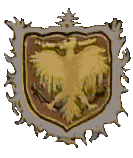
|
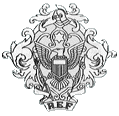
|
||
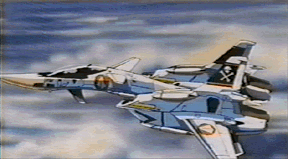
|
|||||
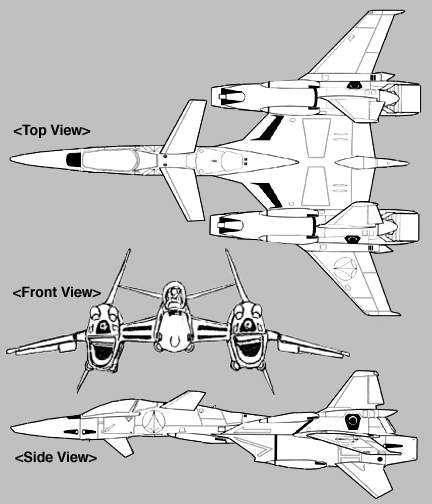
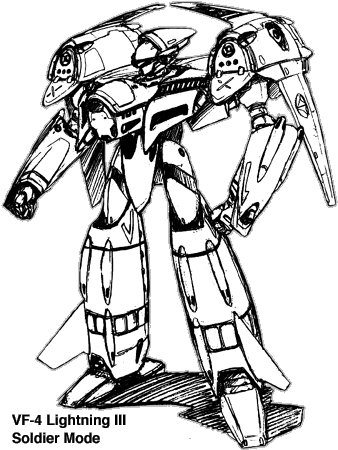
| Fighter | Guardian | Battloid | |||||
|---|---|---|---|---|---|---|---|
| Total Length: | 14.9m | 14.1m | - | ||||
| Total Depth: | - | - | 4.1m | ||||
| Total Height: | 3.7m | 11.2m | 12.5m | ||||
| Total Breadth: | - | 7.4m | 7.4m | ||||
| Total Wingspan: | 14.3m | 14.3m | - | ||||
| Dry Weight | 13.95 metric tons. | ||||||
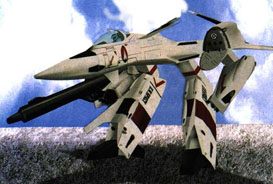
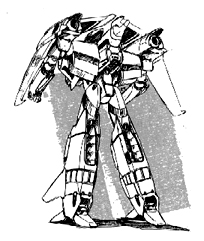
The Carapace missile container is an armored casing with three missile tubes. Each tube can be loaded with 1 x medium range (65 km) Mach 3.0 combined active radar and thermal imager guided AMM-1 Stiletto missile, or with 2 x medium range (65km) Mach 3.2 combined infra-red imager and active radar homing 260mm Diamondback missiles, or with 4 x 190x540mm short range (8.2km) combined active radar and home-on-jam/infra-red imager guided Hammerhead missiles.
The standard internal bay load-outs for this mecha is:
The most common payloads for these mecha are:
The armor of the Lightning is composed of an advanced titanium-steel alloy. The armor stops all small arms and heavy infantry weapons fire, provides good resistance to light mecha-mounted weaponry, such as the Zentraedi 22.3mm HE autocannon round, and poor resistance to medium mecha-mounted weaponry, such as the Valkyrie's 55mm APFSDS round.
The Lightning provides full protection from nuclear, biological, and chemical hazards, using an overpressure cockpit environment activated by radiation and hazardous chemical sensors, or manually when biological warfare conditions are anticipated. The internal consumables supplies can provide atmosphere for one day maximum.
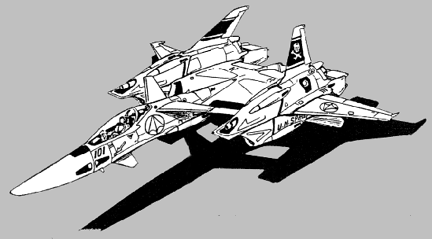
The Lightning design project was started when the first veritech fighter, the VF-1 Valkyrie, was in its prototype stage. The technological advancement of that time took place at such a speed that the impressive Valkyrie could already be improved upon. The VF-X-2 was designed to be a light air-superiority plane. Among the premier features of the plane were wing-mounted engines, inward-canted vertical stabilizers, canard forward wings, and a nose-mounted ventral fin. The legs and arms folded into the wing pods, rather than the Valkyrie's inboard positions. The mecha was to be produced as a lighter and cheaper complement to the Valkyrie.
However, combat experience gathered by the SDF-1 Macross during the return voyage from the outer edge of the solar system highlighted faults in the conceptualisation of the VF-X-2. The initial encounters with heretofore unknown Zentraedi mecha such as the Gnerl fighter and later the Quaedluun-rau Power Armor showed that the multi-purpose VF-1 Valkyrie was less than ideal when used as a ground attack aircraft or as an interceptor. In the latter case, the very fast Valkyrie could still not develop enough speed to keep up with the Zentraedi Gnerl, and neither did it have enough missiles to offset the higher enemy numbers. Compared to the Quaedluun-Rau, the VF-1 and the VF-X-2 both lacked the missile firepower that made the alien design so deadly; in addition, the energy beam armament of the Zentraedi mecha was more effective in space than the cannon armament of the Earth fighters.
It was then decided that the VF-1 was not to be complemented but completely replaced by a new veritech, one with a larger number of long range or short range missiles than the VF-1, and with an energy cannon armament as well. In addition, the new fighter would have to be faster than the Valkyrie, capable of at least keeping up with the Gnerl.
Consequentally, the VF-X-2 underwent design reviews and major structural changes. Eventually, an enlarged combat prototype of this plane was ordered, and it received the designation VF-X-3. While it excelled at what it did, there was no pressing need for a replacement for the Valkyrienor any surplus industrial capacity when it emerged from the factory, immediately after the Zentraedi Holocaust. The three VF-X-3 prototypes flew during these years as experimental craft and technology demonstrators. After about two years, in 2013, conditions changed with the beginning of the Malcontent Uprisings and a rebuild production base. The Valkyrie once again took up its arms, and the Valkyrie successor project suddenly received a high priority once more. In another review, the VF-X-3 was up-armored and given an even more heavier weapons suite. After a prototype known as the VF-X-4, additional changes were made (among others, the large lower hull missile bay was replaced with no less than twelve smaller missile bays spread over the engine pods, arm blocks and lower hull) and the resulting mecha was the VF-4 Lightning.
The new fighter showed no spectacular improvement over the Valkyrie on paper, but the actual combat capability of the mecha increased with several hundred percent over its predecessor. The cannon armament now comprised two heavy particle beam cannons in the wrists in Battloid mode and on the upper engine nacelles in Fighter mode, effectively tripling the cannon firepower in space. The missile armament was doubled over that of the Valkyrie, but more important was that the new standard load-out was carried completely internally. The result was that the effective combat speed range more than doubled over that of the Valkyrie, for this mecha carried its missiles on hardpoints under the wings. The VF-1 thus suffered from a sub-Mach 2 speed restriction when carrying missile racks, requiring them to be jettisoned or fired prior to acceleration above this speed. Naturally this made for a major combat restriction. The Lightning, with its internal storage, could reach its maximum speed while still carrying its standard missile load. Should heavier weapons be required, then the Lightning could mount these on four hardpoints. Doing so imposed a same loaded combat speed limit as the Valkyrie had, but this was required only for such missions as bombing runs or stand-off missile launches, which didn't require quite such high speeds. The new fighter was also designed to use conformal fuel and weapons packs in space if needed, much like the Super Valkyrie.
The VF-4 began manufacture in 2013, when the military and political situation allowed for a 12 ship prototype series. The test flights came off without a hitch, and soon series production began. VF-4s were initially produced for the RDF Naval Air forces, where they replaced the Falcon and older Valkyries. These Lightnings were designated the VF-4A, for the standard fighter, and the VF-4S, effectively the same mecha with a slightly different head styling intended for senior Air Group officers. A training version known as the VF-4B was also procured.
Soon afterwards, a second production run was began for the RDF Spacy forces, where the Lightning was to replace the Valkyries in the strike and long range fighter roles. The VF-4B, as this version was known, was also the first mecha equipped with what was later to become the standard REF sensor suite. FAWT weapons packs, like the packs used on the Super Valkyrie, were also designed and produced, but rarely used, their function being taken over in large part by the use of tanker spacecraft for additional range and with the hardpoints most often used for additional ordnance. In addition, all remaining Naval VF-4A and VF-4S Lightnings were upgraded to the -4B version. This eliminated the "Commanders' model", but as this version usually only called additional enemy attention, its deletion was not mourned overmuch by the senior pilots.
At the time of the REF's main force fold-jump in 2023, over 7100 Lightnings had been built, of which almost 4000 folded with the REF. The remaining Spacy aircraft that had not been lost in combat were placed in reserve at the Tranquillity Sea mecha depots, while the RDF Navy's Lightnings were transferred over to the Southern Cross Navy along with all the RDF Navy's other mecha, ships, and personnel, and continued to serve (with minor upgrades over the years) until the Invid invasion.
Several more versions of the Lightning were designed by the REF. The YF-4E was a Wild Weasel variant that was discarded in favor of the dual-seat VF-6G and -6J Alpha, and the YF-4F was an ELINT version designed in case the Elint Legioss should fail. It did not, and the YF-4E was not procured. The only variant produced was the VF-4D, which upgraded all the electronics as well as the particle beam cannons of the VF-4B. The VF-4D was first manufactured in 2028, and remained the long range mecha of the REF Naval Air Arm until the advent of the Beta fighter in the late thirties.
On Earth and in space, the Lightnings served valiantly in many campaigns. The REF Naval Air Arm mainly used the Lightning as a multi-role heavy mecha, with secondary missions as an anti-mecha ground-attack plane. The mecha is remembered with fondness and respect.
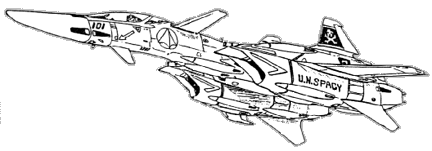
Return to UNDF Veritech Index.
Return to REF Veritech Index.
Go to Robotech Reference Guide Home Page.
Robotech (R) is the property of Harmony Gold. This document is in no way intended to infringe upon their rights.
Content by Pieter Thomassen, Peter Walker and Robert Morgenstern